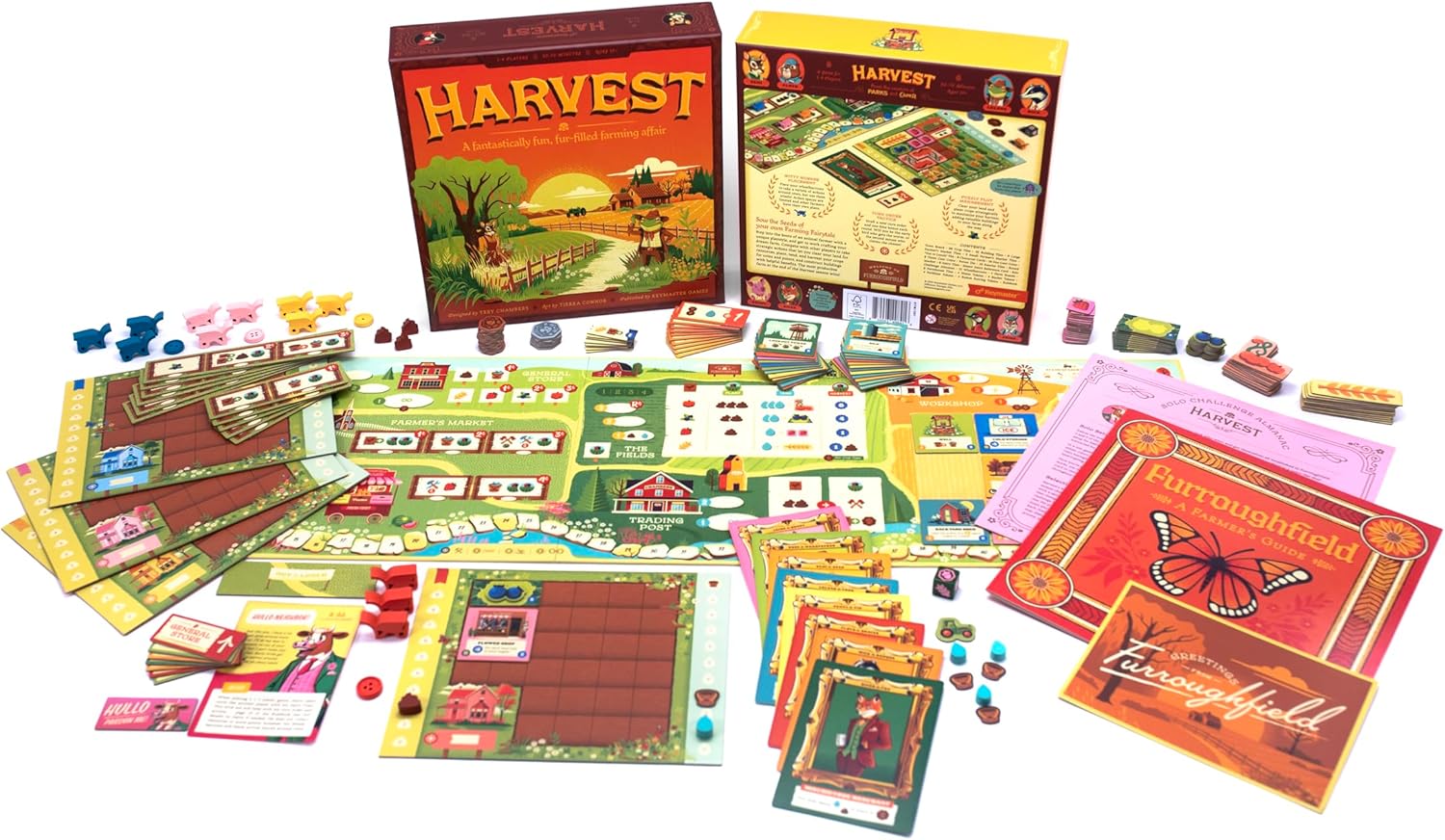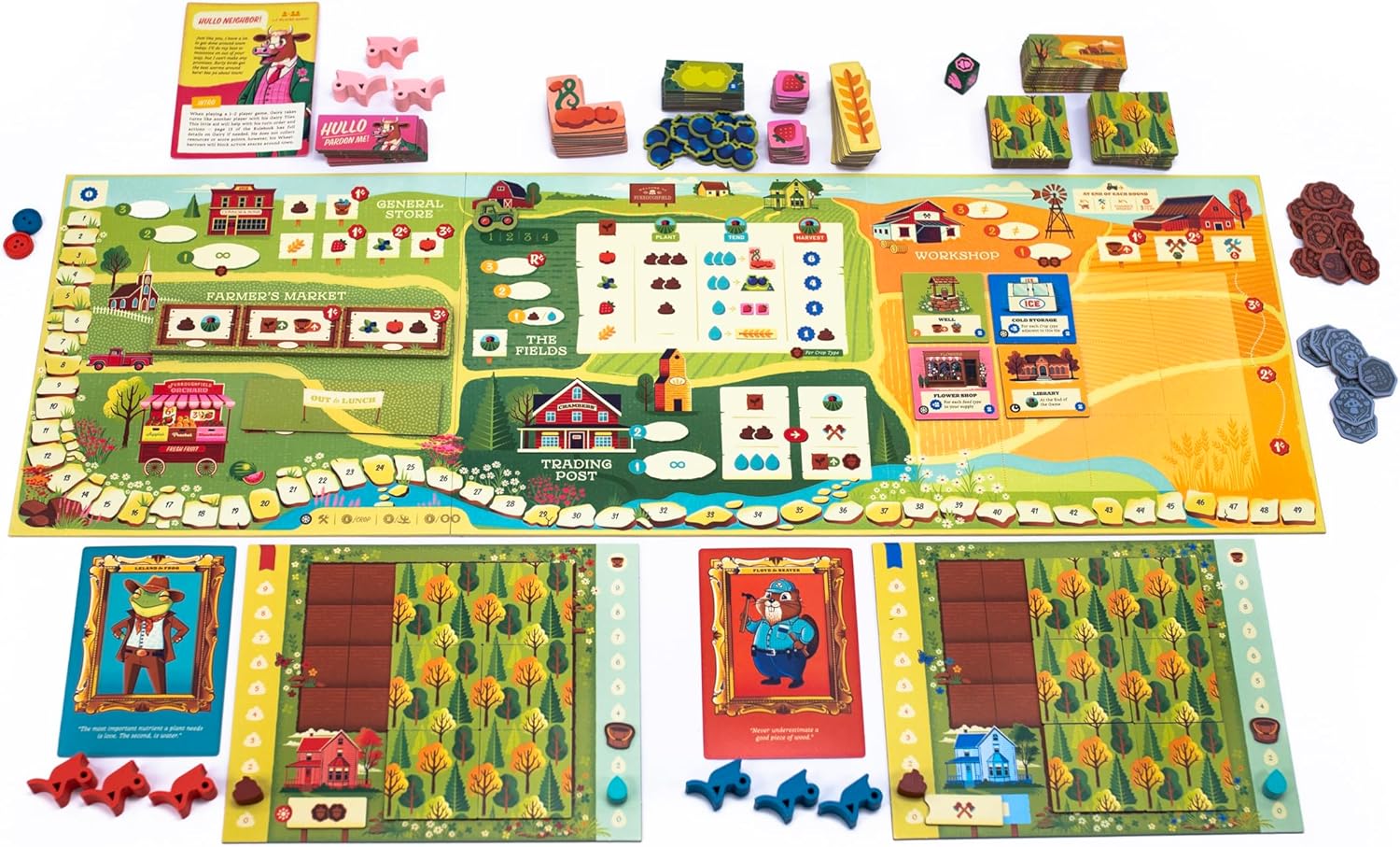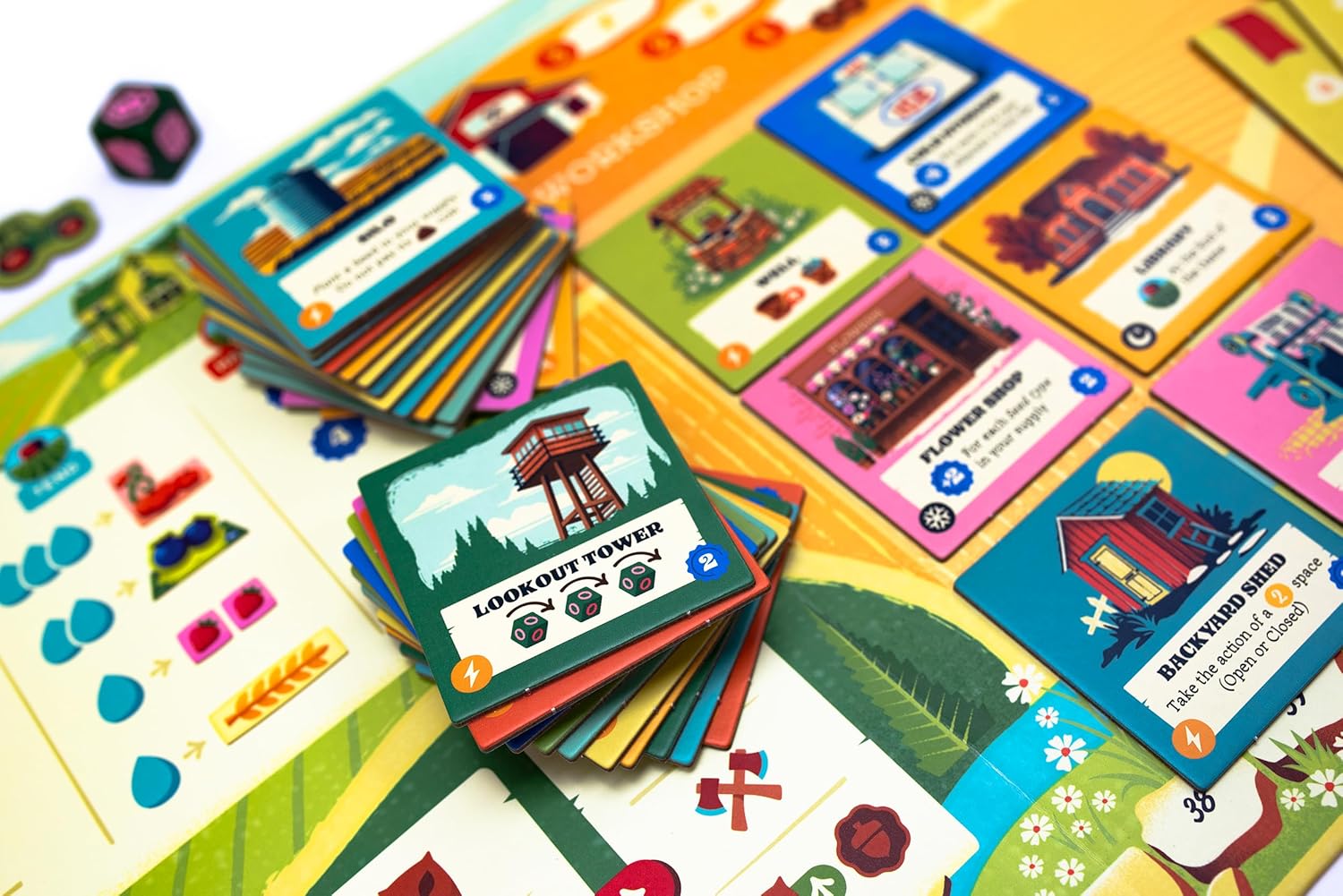Newly redesigned by Trey Chambers, and published by Keymaster Games, Harvest is a really entertaining worker placement game all about being the best farmer in the small town of Furroughfield, the Commonwealth of Free Beasts.
With super cute anthropomorphized animal characters (each with their own special abilities), beautifully illustrated gameboard and pieces (by Tierra Connor), and up to 9 actions a round, Harvest is definitely the game for you if you like worker placement with some unique elements!
What’s in the box?

The copy that I received for review is the base retail version, but folks who backed the Kickstarter, or were able to pick up one of the fancier retail versions, have more items.
Base Harvest comes with a town board that folds into three pieces, 6 large farmer’s market tiles, 5 small farmer’s market tiles, 1 out to lunch tile (used in 1-3 player games), 32 building tiles that have forests on the other side, 8 character cards, 1 Mayor Gairy reference card, 68 seed/crop tiles (12 wheat, 12 blueberries, 12 blueberry bushes, 20 strawberries, 12 pumpkins), 1 tractor round marker, 16 one cent coins, 8 three cent coins, 1 forest die, 10 sunrise tiles, and 8 Gairy tiles. Whew. That’s just for the game!
For players, there are 4 fertilizer tokens, 4 water tokens, 4 bucket tokens, 12 wheelbarrows and 4 button tokens (three wheelbarrows in each color, one scoring button in each color), 8 farmhouse tiles, and 4 farm boards.
Harvest also comes with a Solo almanac with multiple challenges for solo players (more on that later).
I’ll be honest y’all, this game is so pretty, and I love the style of the actual art and illustrations, but I am so grumpy! The deluxe Kickstarter version had premium metal coins, and beautiful custom cut and screen-printed crop tokens and also came with a custom organizing insert. Obviously the deluxe version should have an insert, but for a game this packed, and at a MSRP of ~$60, the basic retail version should have had a simple insert too.
Instead, I had to unbox and pack up like, ten different ziploc bags. Nearly every board game has plastic baggies involved because you can only store items in so many ways, but come on!
I am not fancy enough to 3d print or make my own insert, so I just used a photo storage container (of which I have many to store my Bangladeshi jewelry) to hold all the pieces. It thankfully held everything except for the bigger pieces and main player pieces.

My only other critique is that while the board is gorgeous ,some of the markings are not high contrast, making it hard to see from an angle while sitting around the table. High contrast is always the best for accessibility!
How’s it play?

Harvest was my first real worker placement game, so I had a lot of fun learning how to play and actually playing the game. The game is set up like the photo, with each player placing all their player items around or on their game board and all the game pieces in reaching distance for all the players. The game board actually only has four buildings in the workshop section of the board, and the farmer’s market tiles…in the farmer’s market.
In a two-player game, Mayor Gairy also “plays” and essentially exists to just get in the way because he’s constantly bothering the farm owners! Such a busybody.
Each player also receives a farmhouse tile (the backside has a 50 marker if the player scores that high), which comes into play during the first phase of each round.
In Harvest players work through four rounds, each with three phases. First, in the Sunrise phase, players reveal 3 Sunrise Tiles to form a face-up display. Based on their current Sunrise order (lowest to highest), each player will swap their current Sunrise Tile with another one, and then resolve all actions across the Sunrise abilities available to them. This includes the tile that they just chose, their Farmhouse Tile, and any Sunrise abilities on their character card.
This will include gaining your income for the day (from across the tiles), any bonus abilities/traits that your character has, and either fertilizer or water if possible from the Farmhouse Tile.

If Mayor Gairy is around, he also gets a Sunrise Tile that determines when he goes during the Action phase, but the tile is not part of the display and players can’t swap their tiles for his.
Then it’s time for the Action Phase! In Sunrise Order (lowes to highest), players take turns placing 1 of their wheelbarrows on an open action space on the Town Board in one of five sections: the general store, fields, workshop, farmer’s market, and trading post. Each location has three spots (1, 2, or 3 actions per spot). When players are at a spot with multiple action opportunities, they can do them in any order.
Players continue going back and forth until all the wheelbarrows have been placed, leading to the Sunset Phase. Only one wheelbarrow can be in an action spot at a time unless there is an infinity symbol, which means any number of wheelbarrows can be placed. If Gairy is in play, flip one of his tiles over to tell you where to place him. For example, if the tile has the general store and the up arrow, Gairy’s wheelbarrow will be placed in the highest available action space there.

Finally, each round ends with a Sunset Phase, which starts immediately after all players have placed all their wheelbarrows. Players retrieve the wheelbarrows and shift all the buildings in the workshop one row down. Buildings in the 1c row are discarded from the current game, and the topmost tile in the Farmer’s Market is also discarded. Move the round marker forward one space, and then begin the next sunrise phase. After four rounds, the game is over!
Sounds easy right? It is! But what are the actions available to players and how do you get scores? This is where Harvest gets really good. Each of the five locations has a number of action possibilities.
For example, at the General Store, you can gain a fertilizer, fill your water bucket, and purchase seeds. Wheat is free fortunately, but strawberries, blueberry bushes, and pumpkins go up one cent each in price (1/2/3). However! Blueberries are unique in that when you plant them, you place the bush tile in your field, not the seed. Once you tend your bush, you can then add a blueberry tile on top of the blueberry bush.
So what about the fields? There, you can plant as many seeds as you can (based on what you have and how much fertilizer it costs), tend as many crops as you can by spending its water cost (take a crop of that type from the supply and place it in an empty field space adjacent to a crop of the same time you are tending), or harvest by removing all the crops in your field. You gain a 1 coin for each unique type of crop, and points. You can only get points from harvesting, buying certain buildings, and then again at the end of the game depending on what buildings you have in your field.

At the workshop you can upgrade your bucket, clear land, and build a building (plus roll the forest tile to get a little bonus). The Farmer’s Market has changing special action tiles and the Trading Post lets you, well, trade fertilizer, seed, or water to do a field action, clear land, or upgrade a seed and gain a coin.
Lays down in the fields. That was a lot, but I thought it was worth going into detail so you can see just how many options players really have each round. If you manage to get your wheelbarrow on the highest action spot in each round that’s 36 (!) action options available to you in the game, not including any character bonuses like Jaime the Rabbit, who gets a fourth wheelbarrow action before the Sunset Phase begins.
The verdict?
Except for my complaints about the lack of an insert and some accessibility issues on the game board, I honestly loved playing Harvest. I can absolutely see why it did so well on the Kickstarter — raising over $350,000 to bring the game to life — and based on what I’ve seen of the original version, this one is definitely brighter and more engaging (to me)!
I particularly loved the Gairy function. A lot of times, games with a “AI” player end up making the actual human players figure things out or do work, but with Gairy there’s no guessing. You flip some tiles, move his wheelbarrows where they go, and hope his sunrise tiles are highest so he goes last each time.
The Solo Almanac of challenges is also a delight with 17 (!) different challenges based on which character you play as and tweaks to set up. One of them included making parts of your field toxic so you’d have to work to remove forest before you can even get any planting done!

Clearly Chambers (and anyone else involved in helping to test the game) did a thoughtful job thinking through each of the challenges and how to make them fun for the solo player. I don’t play solo games all that often, but I’ve already looked through the almanac and am excited to start playing them when I have a free couple hours here and there!
One other thing that I love and want all games to do moving forward is to include an icon reference page. The last page of the rulebook has a legend for all the icons so once my friends and I learned how to play, we were able to use that as a quick reference. Player reference sheets/cards and icon pages are so useful for games like Harvest. And as I’ve said time and time again, saturated games for the win. I need to be able to see what the heck I’m doing and enjoy it!
You can pick up Harvest at Amazon now! And if you want to watch the game explained by Farmer Paula, in her wheelbarrow, well, check out the hilarious video on Youtube.
Images and review copy courtesy of Keymaster Games
Have strong thoughts about this piece you need to share? Or maybe there’s something else on your mind you’re wanting to talk about with fellow Fandomentals? Head on over to our Community server to join in the conversation!

